Port Overview
This assessment has been done following the earthquake and tsunami that struck Palu, Central Sulawesi on 28 September 2018. As of 12 October 2018, the port has returned to normal operations for commercial and non-commercial cargo.
Key port information may also be found at: http://www.inaport4.co.id/branch/read/1/19 or http://www.maritime-database.com
|
Port Location and Contact |
|
|---|---|
|
Country |
Indonesia |
|
Province or District |
Central Sulawesi |
|
Nearest Town or City with Distance from Port |
Palu City |
|
Port's Complete Name |
PT. Pelabuhan Indonesia IV (Persero) Cabang Pelabuhan Pantoloan |
|
Latitude |
00° 42’ 03” S |
|
Longitude |
119° 51’ 03” E |
|
Managing Company or Port Authority |
PT. Pelabuhan Indonesia IV (Persero) Cabang Pelabuhan Pantoloan (State-owned company) |
|
Management Contact Person |
Mr. Nengah, General Manager, Mob: +6282154935594/+6281318888270 Mr. Rusdin, Operations Manager, Mob: +6281341686877 |
|
Nearest Airport and Airlines with Frequent International Arrivals/Departures |
Mutiara SIS Al-Jufrie Airport, Palu, Central Sulawesi, located about 30 km away from the port |
Port Picture

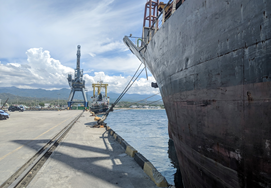
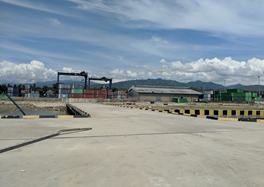
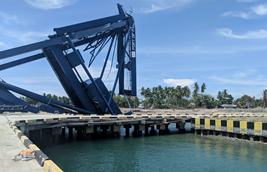
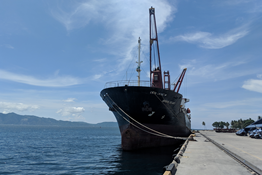
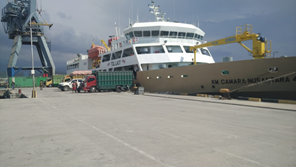
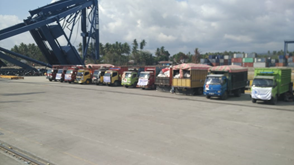
Source: WFP
Description and Contacts of Key
Companies
The main shipping companies operating at the Port of Pantoloan:
- PT. Meratus Line
- PT. Temas Line
- SPIL
The main freight forwarding company operating at the Port of Pantoloan:
- Association of Logistics and Forwarders Indonesia (ALFI)
For more information regarding port contacts, please see the following link:
Discharge Rates and Terminal Handling Charges
The port operator, Pelindo, is planning to increase the port service charges by 15 percent, and the ship service charges by 30 percent. The new rates will be applicable from 1 December 2018. Rates breakdown will be provided once available.
Berthing Specifications
All vessels can berth however, due to damage to port infrastructure, vessels must be equipped with a ship crane for unloading purposes
|
Type of Berth |
Quantity |
Length (m) |
Maximum Draft (m) |
Comments |
|---|---|---|---|---|
|
Conventional Berth |
One general berth |
420 meters |
16 meters (14 meters before tsunami) |
|
|
Container Berth |
|
|||
|
Silo Berth |
Not available |
|
||
|
Berthing Tugs |
In the general berth |
No dedicated berth |
||
|
Water Barges |
Temporarily supplied by PDAM via water tank truck |
Drilled wells are not operational |
Port Handling Equipment
Port handling equipment is managed by the port operator, Pelindo.
|
Equipment |
Available |
Total Quantity and Capacity Available |
Comments on Current Condition and Actual Usage |
|---|---|---|---|
|
Dockside Crane |
No |
||
|
Container Gantries |
No – collapsed |
Plan to rebuild by the end of 2018 |
|
|
Mobile Cranes |
No |
||
|
Reachstacker |
Yes |
2 units available (45 tons capacity) |
Both operational |
|
RoRo Tugmaster (with Trailer) |
No |
||
|
Grain Elevator with Bagging Machines |
No |
||
|
Transtainer |
Yes |
2 units |
1 operational, 1 broken |
|
Forklifts |
Yes |
3 units available (32 ton; 7 ton; 3 ton) |
Operational |
Container Facilities
One 5,000 hectare Container Yard (CY) is currently available.
|
Facilities |
20 ft |
40 ft |
|---|---|---|
|
Container Facilities Available |
Yes, 5 hectares of CY for 20” and 40” containers (capacity 200,000 TEUs / year) |
|
|
Container Freight Station (CFS) |
No dedicated station, the existing CY and warehouse can be used as CFS |
|
|
Refrigerated Container Stations |
6 plug-in points available |
|
|
Other Capacity Details |
||
|
Daily Take Off Capacity |
Following the earthquake on 28 September 2018, the only available option for offloading cargoes from the vessel is via onboard ship crane as the existing container crane was damaged. With one ship crane, maximum take-off capacity is around 7 to 9 units of 20” container per hour (before the earthquake, the daily take of using the container crane was around 120 to 150 TEUs per day) |
|
|
Number of Reefer Stations |
6 plug-in points available |
|
|
Emergency Take-off Capacity |
Please refer to “Daily Take Off Capacity” |
|
|
Off take Capacity of Gang Shift |
- |
- |
Customs Guidance
The cargo is largely customs cleared before it gets to the Port of Pantoloan. However, if there is cargo that requires customs clearance, the procedure can be done at Pantoloan.
For more information on Indonesia Customs guidance, please see the following link: 1.3 Indonesia Customs Information
Terminal Information
Main Storage Terminal
There are two warehouses of 1,000 m2 capacity. One of the warehouses is currently rented out, the other warehouse unit is available, but the door is damaged (currently guarded by port security).
Stevedoring
There are two stevedoring companies working at the port:
- PT. BGR (Persero) –State-owned company
- Labour Association from Wani Port
Port Security
|
Security |
|
|---|---|
|
ISPS Compliant |
Yes (before earthquake) |
|
Current ISPS Level |
Considering the damage sustained by the port perimeters, the levelling system is not applicable at the moment. |
|
Police Boats |
No dedicated. |
|
Fire Engines |
To be checked. |


